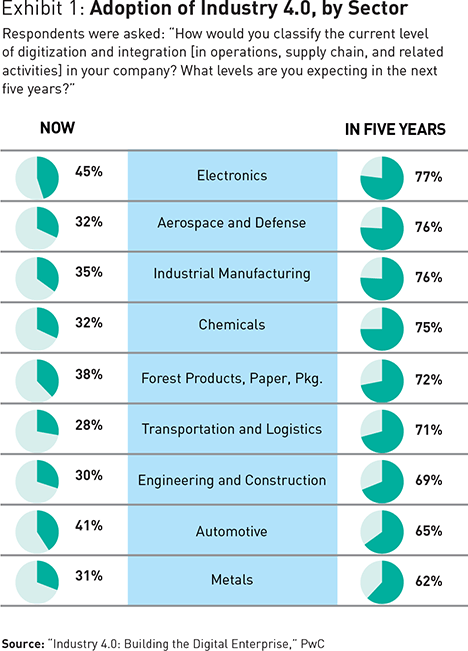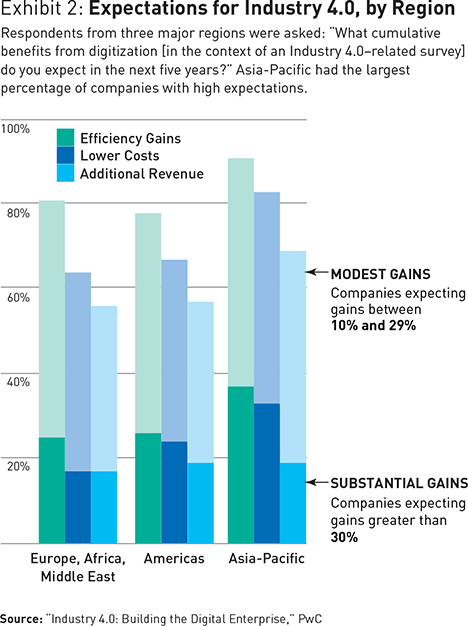A strategist’s guide to Industry 4.0
Global businesses are about to integrate their operations into a seamless digital whole, and thereby change the world.
Industrial revolutions are momentous events. By most reckonings, there have been only three. The first was triggered in the 1700s by the commercial steam engine and the mechanical loom. The harnessing of electricity and mass production sparked the second, around the start of the 20th century. The computer set the third in motion after World War II (see “The Man Who Made the Computer Age Possible,” by Jeffrey E. Garten).
It might seem too soon to proclaim that the fourth industrial revolution, spurred by interconnected digital technology, has begun. But Henning Kagermann, the head of the German National Academy of Science and Engineering (Acatech), did exactly that in 2011, when he used the term Industrie 4.0 to describe a proposed government-sponsored industrial initiative.
When you look closely at the rapid pace of digitization in industry today, the name doesn’t seem hyperbolic at all. It is a signal of sweeping change that is rapidly transforming many companies and may catch others by surprise.
The term Industry 4.0 refers to the combination of several major innovations in digital technology, all coming to maturity right now, all poised to transform the energy and manufacturing sectors. These technologies include advanced robotics and artificial intelligence; sophisticated sensors; cloud computing; the Internet of Things; data capture and analytics; digital fabrication (including 3D printing); software-as-a-service and other new marketing models; smartphones and other mobile devices; platforms that use algorithms to direct motor vehicles (including navigation tools, ride-sharing apps, delivery and ride services, and autonomous vehicles); and the embedding of all these elements in an interoperable global value chain, shared by many companies from many countries.
When robotics, 3D printing, data analytics, the Internet of Things, and digital fabrication are joined together, they integrate the physical and virtual worlds.
These technologies are often thought of separately. But when they are joined together, they integrate the physical and virtual worlds. This change enables a powerful new way of organizing global operations: bringing the fungibility and speed of software to large-scale machine production. Under the Industry 4.0 model, product design and development take place in simulated laboratories and utilize digital fabrication models. The products themselves take tangible form only after most of the design and engineering problems have been worked out. The networks of machinery that have engendered industrial society become hyper-aware systems of highly flexible technology, responding rapidly not just to human commands but to their own perceptions and self-direction.
This technological infrastructure is still in its early stages of development. But it is already transforming manufacturing. Companies that embrace Industry 4.0 are beginning to track everything they produce from cradle to grave, sending out upgrades for complex products after they are sold (in the same way that software has come to be updated). These companies are learning mass customization: the ability to make products in batches of one as inexpensively as they could make a mass-produced product in the 20th century, while fully tailoring the product to the specifications of the purchaser. As the movement develops, these trends will accelerate. So will the invention of new products and services, including new ways of tackling today’s most difficult problems: climate change and pollution, energy demand, the pressures of urbanization, and the problems that accompany aging populations.
The Industry 4.0 movement started in Germany, and many of that country’s leading industrial companies have strong initiatives. According to the Economist, the list includes BASF, Bosch, Daimler, Deutsche Telekom, Klöckner & Co., and Trumpf. The momentum is rapidly growing elsewhere as well, particularly in the United States, Japan, China, the Nordic countries, and the United Kingdom. Such influential global industrial behemoths as Siemens and GE have fully embraced the approach; both companies’ CEOs and senior executives have declared that it is now a core part of their identity (see “Siemens CEO Joe Kaeser on the Next Industrial Revolution,” by Daniel Gross).
In 2015, PwC surveyed more than 2,000 companies from 26 countries in the industrial production sectors, including aerospace and defense; automotive; chemicals; electronics; engineering and construction; forest products, paper, and packaging; industrial manufacturing; metals; and transportation and logistics. In this global Industry 4.0 survey, one-third of the respondents said their company had already achieved advanced levels of integration and digitization, and 72 percent expected to reach that point by 2020 (see Exhibit 1).
This momentum reflects expectations of rapid payoffs in business results. An overwhelming majority (86 percent) of the survey respondents said that on the basis of their experience to date, they expected to see both cost reductions and revenue gains from their advanced digitization efforts. Nearly a quarter expected those improvements, in both cost savings and revenues, to exceed 20 percent over the next five years.
The cost savings are largely a result of greater efficiency and technological integration. Industry 4.0 replaces redundant legacy systems, such as those for operations management and enterprise resource planning, with a single, enterprise-wide, interoperable whole — which is much less expensive. Because user experience in operational systems has improved in recent years, employees tend to be happier and more productive with Industry 4.0 (see “Your Employees’ User Experience Should Be a Strategic Priority,” by Elizabeth Rosenzweig). This lowers costs for training, support, and staff turnover, and raises operations speed. Predictive analytics, when used to support real-time quality control and maintenance, contributes to the savings by smoothing operations and reducing breakdowns.
The revenue gains, for their part, come largely from offering new digital features and products, or from introducing analytics and other new digital services to customers. In addition, the availability of real-time data enables companies to offer more personalized products and customized solutions, which usually generate significantly higher margins than mass-manufactured offerings. The opportunities are promising enough that about 55 percent of survey respondents expected to see their investment returned within two years, a short time considering the amount of capital required.
The Web of Technologies
As your company becomes active in Industry 4.0, you’ll find the benefits go far beyond extending your digital reach or selling new types of products and services. It will establish your company, your employees, and your entire ecosystem of suppliers, partners, distributors, and customers as a fully interconnected, integrated digital network, linked to other networks around the world.
Three aspects of digitization form the heart of an Industry 4.0 approach.
• The full digitization of a company’s operations, integrated vertically (to include every function and the entire hierarchy) and horizontally (linking the suppliers, partners, and distributors in the value chain and transferring data among them seamlessly). One example is leading-edge inventory management systems, which connect retailers, distribution centers, transporters, manufacturers, and suppliers. Each transparently receives data about the others’ supply levels, places and fulfills orders automatically, and triggers maintenance and upgrades. This smooths out the gluts and shortages of a typical supply chain, and enables the chain to compensate for sudden interruptions (such as those from natural disasters) and to easily test new products and services in particular geographic locations.
A more advanced example is the design of flexible fabrication facilities, which use programmable robots to perform most of the operations. These represent the virtualization of the physical world. New products — and, indeed, entirely new assembly lines — can be prototyped in software before being put in place. It is almost effortless to simulate a new plant design, test it for flaws, and invest in the physical machinery only when it is clear it will work well. These advances make it much easier and less expensive to bring new products to market, which in turn makes it easier and less expensive to test new offerings without a full launch.
• The redesign of products and services to be embedded with custom-designed software, so that they become responsive and interactive, tracking their own activity and its results, along with the activity of other products around them. When captured and analyzed, the data generated by these products and services indicates how well they are functioning and how they are used. For example, the equipment used in a shipping port or on a construction site can now detect an impending mechanical breakdown and prevent it. The next generation of this equipment will be able to compare the efficiency of various machines and suggest more efficient deployment. Another example is motor-vehicle software, which is evolving to enable cars, trucks, and other vehicles to be repaired via downloaded software upgrades instead of mechanics.
Industrial products that track their own activity will also provide powerful insights into those who use them: how they operate, where they face delays, and how they work around problems. The manufacturers can use this data to develop profitable new products and services. For example, the manufacturers of printing machines have traditionally made the bulk of their revenues from selling and servicing presses. When the presses generate usage data, the manufacturers can become brokers of press time, knowing when customers’ presses are available, and negotiating printing prices accordingly.
• Closer interaction with customers, enabled by these new processes, products, and services. Industry 4.0 makes the value chain more responsive, allowing industrial manufacturers to reach end customers more directly and tailor their business models accordingly. Products as diverse as aircraft engines and software are increasingly offered as services, often on a subscription basis. One of many examples is Atlas Copco, a manufacturer of air compressors based in Nacka, Sweden, which is moving away from selling its equipment directly, and, instead, is billing only for the compressed air that is used. The machines installed at customer sites can monitor the flow of compressed air and adjust the output according to customer need.
Industry 4.0 also enables business models that take advantage of the economics of mass customization, where every product is, in effect, created as a batch of one. Currently, digital fabrication is used primarily for prototyping. But as it becomes more sophisticated, and as software and robotics are integrated into new types of assembly lines, high levels of specification will become the norm. The appliance manufacturer Haier, for example, already makes its washing machines and refrigerators in China to order. Customers specify the features they want on their computers or phones, or at kiosks in Haier’s retail stores, and those specs are transmitted directly to the assembly line.
Making Industry 4.0 work requires major shifts in organizational practices and structures. These shifts include new forms of IT architecture and data management, new approaches to regulatory and tax compliance, new organizational structures, and — most importantly — a new digitally oriented culture, which must embrace data analytics as a core enterprise capability.
To understand why analytics are so important to Industry 4.0, consider the last major operational revolution, the quality and lean production approach that began in the Japanese auto industry and spread around the world. Exercises such as the “five whys” and statistical analyses taught manufacturing engineers — and people on the assembly line — to monitor the variance in their efforts, seek opportunities for improvement, and attune themselves to the flow of the work. This resulted in unprecedented levels of quality and reliability. Industry 4.0 brings that same fine-grained awareness into the machines themselves; it makes the value chain self-conscious. The machines can be programmed, for example, to detect when they are wasting material, taking an inefficient supply chain route, or going awry in some other fashion. They can bring that information to the attention of company leaders, in the same way that a GPS navigator can relay information about traffic congestion to help a driver change course en route.
Industry 4.0 brings fine-grained awareness into the machines themselves; it makes the value chain self-conscious.
In the PwC study of Industry 4.0, the most commonly cited difficulty in building an analytical capability was the lack of people with the expertise to conduct the analysis. Other prominent concerns — poor data quality, lack of access to the right data, and lack of top-level support — reinforce what has long been known: Doing analytics is difficult. The processes of Industry 4.0 provide mountains of data about customer demands and value chain logistics. But if you can’t make sense of that data and use it to boost efficiency, grow closer to your supply chain partners, and develop products and services your customers actually want, much of the effort is wasted.
Analytics can yield insights that help you reshape your operational designs. For example, analysis of your customers’ daily and seasonal use of machinery can help you improve production schedules. Data about employee recruiting can help you predict your next talent shortfalls. Production data can illuminate opportunities to eliminate downtime or speed up throughput. Analytics can also help you balance trade-offs: for instance, the data might help an oil company decide to place a refinery offshore, even though the costs are higher, because it will yield more uptime and thus more profits.
Analytics can also help you meet aspirations that seemed nearly impossible before. For example, many companies struggle to improve their ecological footprint. Analytics can identify wasted materials and suggest ways to reclaim them, or to use them as inputs for other industrial processes. Analytics can also reveal new markets, or opportunities for growth in existing markets, that were not obvious before.
First Movers and Platforms
There are, of course, many challenges associated with Industry 4.0. It requires openness with data and collaboration, to an extent that feels uncomfortable at many companies. The requisite technological capabilities and human skills are often in short supply. It involves new and unfamiliar ways of organizing production. And, perhaps most daunting, it represents a leap of faith; investments must be made today, while many of the products and processes involved in the approach are still unknown.
Nonetheless, companies that hold back, waiting to see how it all turns out before investing, will fall behind. As World Economic Forum founder Klaus Schwab put it in his recent book The Fourth Industrial Revolution (World Economic Forum, 2016), “Contrary to the previous industrial revolutions, this one is evolving at an exponential rather than linear pace.… It is not only changing the ‘what’ and the ‘how’ of doing things, but also ‘who’ we are.”
A small group of companies — 71 of the respondents to our survey, representing only 4 percent of the total — have chosen to lead the way. These “first movers” say they have invested 6 percent or more of their revenues since 2013 in Industry 4.0 efforts, and also claim high levels of digitization and competitive advantage. They appear to be finding rapid payoffs in efficiency, cost savings, and opportunities for innovation; more than half are among the group expecting to see rapid business returns on their investments.
Some of the advantage enjoyed by first movers has to do with the virtuous circle they kick off when they move more quickly than competitors. If first movers can realize their expected cost savings and revenue gains, they will generate more capital to reinvest in their Industry 4.0 strategies, enabling them to improve their operational performance — and increase their lead over competitors — even further. As a result, the investment required for laggards to catch up will grow. Advanced implementation of Industry 4.0 may provide enough competitive advantage that it will be seen by investors as a qualifier for funding.
A still more compelling factor is the platforms that first movers create. A platform is a nexus of exchange and interoperable technology that allows a wide range of vendors and customers to seamlessly interact. The most successful first movers of the software and Internet industries — Amazon, Apple, eBay, Facebook, Google, and Microsoft among them — all cemented their position with powerful and distinctive platforms. Apple and Google, for example, collect 30 percent of the revenue for apps sold in their app stores.
First movers on Industry 4.0 will seek a similar advantage. GE and Siemens are already moving to solidify their position as platform providers. Each has developed a cloud-based system for connecting machines, devices, and systems (such as enterprise resource planning systems) from a variety of companies — facilitating transactions, operations, and logistics seamlessly among them, and collecting and analyzing data for use by all.
On an industrial platform of this sort, market intelligence information, gathered from the machinery and the behavior of people in the system, moves smoothly into product development and manufacturing. Equipment and software from multiple vendors are connected, with the connections extending beyond the company’s own walls into the value chain to external distributors and suppliers. The net effect is to bring customers closer to operations, analyzing their data to better forecast their needs, improve products, and develop new offerings, often customized to individuals.
Smaller companies can also establish themselves through the platform concept. Some solar panel manufacturers, for example, have built innovative revenue models that are forerunners to Industry 4.0 models. Instead of directly selling panels to their business customers, they sell the electric power those panels generate. The manufacturer installs the panels (financing the hefty up-front costs), and maintains and upgrades them at a compelling price. In exchange, the customer signs a 20- or 30-year contract. The manufacturer assumes that no matter what happens during the subsequent decades, its analytic prowess — incorporating weather, financial, and operational data — will enable it to adopt changing technologies and deliver energy at low cost. It will keep the panels clean, use sensors to detect equipment breakdowns (solar panels have few moving parts, so breakdowns are relatively rare), and upgrade the panels when photovoltaic technologies improve.
Platforms are successful in the Internet 4.0 context because of a phenomenon known to economists as “lock-in.” Once a customer commits itself to a technologically comprehensive platform — especially one that offers multiple services, with costs that keep diminishing and an expanding network of users — it is increasingly difficult to switch. Every new customer expects to be able to connect to its own network of businesses, so new customers sign up as well. This network effect, as it’s called, further reinforces lock-in.
For example, over the course of 20 or 30 years, a solar panel manufacturer’s platform will probably be linked through Industry 4.0 relationships to a few other companies’ platforms. These in turn will influence other choices that solar customers make. As these customers add interrelated technologies, they will likely find their operations locked into that ecosystem — while competitors’ customers might be locked into a different ecosystem. Ultimately, two or three platforms will probably cover most of the sector, just as Apple’s iOS and Google’s Android currently divide the smartphone sector. In Industry 4.0, as in other technological fields, whoever owns a platform owns access to the customer, and can place its own brand on the aggregated work of many other enterprises.
The Globalization Accelerator
As the fourth industrial revolution binds companies and countries ever more tightly together through worldwide supply chains and sensor networks, it will increasingly promote globalization. At the same time, it will link closely to local companies. That helps explain why the survey results differed considerably by region. Asian companies, especially those based in Japan and China, expected the greatest gains from the digitization of Industry 4.0, followed by companies in the Americas, and then Europe and the Middle East. Japanese companies are already the most advanced in this field, followed by those based in the U.S. and then Europe. Companies in all regions expect to catch up within five years (see Exhibit 2).
As Industry 4.0 takes hold around the world, emerging nations probably have the most to gain. They can leverage digitization to gain efficiency in their horizontal integration, working with the global manufacturers to whom they supply all manner of raw materials, parts, and components. The more closely they align with the platforms of Industry 4.0, the more potential customers they will be able to reach.
This great integrating force is gaining strength at a time of political fragmentation — when many governments are considering making international trade more difficult. It may indeed become harder to move people and products across some national borders. But Industry 4.0 could overcome those barriers by enabling companies to transfer just their intellectual property, including their software, while letting each nation maintain its own manufacturing networks. Future advances in 3D printing, for example, will enable virtually any company to set up shop anywhere, and to fabricate components, spare parts, and (potentially) industrial equipment without having to ship the finished pieces. Operations will become more global and more local at the same time.
Unresolved issues abound. For example, will governments change their customs activities and tax structures to account for a world in which physical goods of all kinds rapidly decrease in value compared with the intangibles — intellectual capital and ongoing support, for example — that distinguish them? Will a digital fabrication plant be considered a full-scale manufacturing location? Will this type of manufacturing create jobs? Or supplant them with technology? As the intellectual property value of software and services increases, will new cybersecurity challenges arise? Or will cradle-to-grave tracking of products make it easier to enforce global rules about IP theft, and to trace violations? The centuries-long process of globalization has always presented new challenges and new risks; now, as we stand on the brink of an entirely new technological way of life, the challenges and risks may come in unfamiliar new forms.
Your Company’s Path
Digital capabilities are vital to move forward with Industry 4.0. Developing them takes time and concentration; a step-by-step approach is important. But you must move with alacrity, so you don’t forfeit the first-mover advantage to competitors. These six steps have been critical for the successful companies we’ve seen.
1. Map out an Industry 4.0 strategy up front. Evaluate your own digital maturity now, versus where you need to be. Set clear targets for closing the gap. Prioritize the measures that will bring the most value to your business and make sure these are aligned with your overall strategy. Gain commitment to this approach from the full range of top company leadership, and make sure that commitment is evident to people throughout the enterprise, who will base their decisions on what they believe their leaders want and expect.
2. Start with pilot projects. Use them to establish proof of concept and demonstrate business value. Not every project will succeed, but they will all help you learn the approach that works for your company. With early successes, you can also gain buy-in from the organization, and secure funding for a larger rollout. For the early pilots, define a relatively narrow initial scope, but incorporate the end-to-end concept of Industry 4.0 — from materials to the customer delivery (and services after the sale). Design pragmatically to compensate for standards or infrastructure that doesn’t yet exist. Collaborate with digital leaders outside your company’s boundaries; work with startups, universities, or industry organizations to accelerate your digital innovation.
3. Define the capabilities you need. Building on the lessons learned in your pilots, map out in detail the capabilities you need to achieve your goals, and develop a blueprint for building (or acquiring) those capabilities. Include technological enablers, such as an agile and highly functional IT infrastructure with well-designed user interfaces, that can propel your business processes forward. Also include strategies for recruiting and developing the right employees and attracting the right companies to work with. Your success with Industry 4.0 will depend on the skills and knowledge you can deploy.
4. Become a virtuoso in data analytics. Success with Industry 4.0 depends on your prowess in unlocking data possibilities, and using analytics in creative and effective ways. Establish cross-functional analytics capabilities, tied closely to the strategic priorities of the whole enterprise, drawing on in-house staff and outsourced expertise. Develop ways of combining data from different parts of the business — for example, your quality, logistics, and engineering functions (which may have had separate and incompatible monitoring systems before this) — and apply these methods to as many domains as possible, particularly those that differentiate your company or attract customers. Learn to get value out of data through intelligent systems design, using real-time analytics to tailor products to customers and continually improve your processes. Think big, but start small, with “proof of concept” projects.
5. Transform into a digital enterprise. Capturing the full potential of Industry 4.0 will probably entail major changes to your company’s practices and the attitudes underlying them. Set the tone from the top, with clear leadership, commitment, and vision from the C-suite and financial stakeholders. Foster a digital culture: All your employees will need to think and act like technologically adept natives, willing to experiment, learn new ways of operating, and adapt everyday processes accordingly. Remember that change doesn’t stop once you’ve implemented Industry 4.0. Your company will need to reinvent its capabilities continually, at faster rates than in the past, to stay ahead of the game.
6. Adopt an ecosystem perspective. Develop complete product and services solutions for your customers. Use partnerships or align with platforms if you cannot develop a comprehensive offering on your own. You may find it difficult to share knowledge with other companies, and you may prefer acquisition to collaboration. But look for ways to bridge your own company’s boundaries — perhaps with technical standards — so that you can profit from being part of platforms that you don’t fully control. The greatest breakthroughs in performance occur when you actively understand consumer behavior and can orchestrate a distinctive role for your company within a complex ecosystem of partners, suppliers, and customers.
Finally, don’t buy the hype. Buy the reality. Industry 4.0 will be a huge boon to companies that fully understand what it means for them. Change of this nature will transcend your company’s boundaries — and probably the national boundaries of the countries where you do business.
Reprint No. 16213
Author profiles:
- Reinhard Geissbauer leads the Industry 4.0 practice in Europe, the Middle East, and Africa for Strategy&, PwC’s strategy consulting business. Based in Munich, he is a partner with PwC Germany. He supports industry leaders in developing digital product and service portfolios, digital ecosystem solutions, and strategies and applications for smart supply chains and smart manufacturing.
- Jesper Vedsø is a partner with PwC Denmark, based in Copenhagen. He is part of PwC’s leadership team for the industrial products sector, and is responsible for the firm’s global Industry 4.0 survey. He advises leading industrial and transportation companies on how they can incorporate Industry 4.0 principles in their business models.
- Stefan Schrauf is a leading practitioner with Strategy&, overseeing its Industry 4.0 practice for Germany. He is a partner with PwC Germany, based in Munich. He advises global corporations on developing operations capabilities and becoming digital enterprises.
- Also contributing to this article were Usha Bahl-Schneider, senior manager with PwC South Africa; Elizabeth Montgomery, manager with PwC Germany; and Stefanie Zuberer, consultant with PwC Germany.








